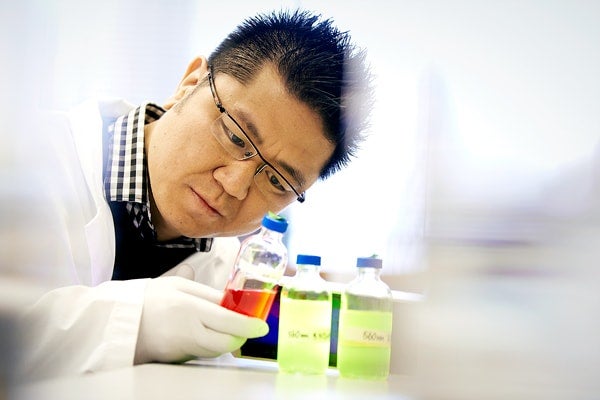
Warren Chan, global leader in nanotechnology
Published: February 27, 2013
Warren Chan is a professor at the Institute of Biomaterials and Biomedical Engineering (IBBME) at the University of Toronto, where he holds a Canada Research Chair in Bionanotechnology. Professor Chan works with quantum dots and nanoparticles—tiny particles that are helping researchers develop portable and cheaper diagnostic equipment for infectious diseases such as HIV, Hepatitis B and Hepatitis C, malaria and syphilis.
Chan has co-founded two companies, including Cytodiagnostics, which is among the top five nano-biotechnology companies in the world. He also contributes to national and international agencies examining the impact of nanomaterials and developing regulations governing their use.
Chan is one of three faculty members at U of T to receive an E.W.R. Steacie Memorial Fellowships this year. The fellowships were created to enhance the career development of outstanding and highly promising scientists and engineers who are faculty members at Canadian universities.
U of T News asked Chan about his research and the implications it holds for future generations.
Tell us about your research.
Everyone knows about barcodes; basically, these are a way for a store to keep track of its inventory. Well, we’re working on creating molecular barcodes, only we’ve done this with tiny beads and have put different coloured particles in them. Different beads will allow you to detect, based on colour signals, whether your system has a particular bug such as malaria or HIV.
What ends up happening is that the colour of the beads identifies the gene targets – for instance, green and orange beads can identify gene targets for malaria and HIV. But we also made it so that if that disease is present, it will bind to the surface of the target gene with another coloured particle, say red, to form a sandwich. If you don’t have malaria, you’ll see the green beads only, but you’ll see the green beads plus a red tint if malaria is present.
We took this technology and put it on a chip, so actually you can put it on a slip of paper or a glass slide. We’re developing a portable prototype so that you can basically spit on a strip of paper and an hour later you’ll be able to tell whether you’ve been infected with that disease based on the colours of the beads.
Currently we’re in a prototype phase. We’re trying to turn the laser and microscope that allows you to detect the coloured beads into a hand held device.
What kind of impact could this research have for society?
Take a disease like the flu, where it just walloped Toronto. But with this technology, you spit into a little slide, plus some dried reagents to crack out the bug, wait 20 minutes, and use your cell phone to view it and tell you whether the bug is present. You can do your own screening and diagnosis. The cool thing about a cell phone is that, because you can detect and store information, you can track diseases.
In the same way that social media is changing the way we communication, this hand held diagnostic platform can help us change the speed of diagnosing and monitoring the spread of infectious bugs.
We’re making these diagnostic tools cheap and portable, and anyone can use it. Say you’re going on a trip to South America where certain diseases are more readily communicable. Just pack your device and your phone can used for diagnoses. If you’ve contracted a disease, you can connect to medical wikis or even doctors to see whether you should seek treatment.
What sort of changes/developments have you witnessed over the course of your career?
Funny, ten years ago, it took us for or five years to figure out how to get these quantum dots code beads to make barcodes. You have to code very carefully. Then we went through three to four years of trying to optimize the technology: as in how much of the green target gene do we use, or how much of the red detection bead do we need? Now we’re refining the platforms. We’re putting all the pieces together.
What drew you to this field – and to this particular focus?
Working on infectious disease diagnostics just became a natural fit. I’m trained as an Analytical Chemist which are researchers whose goal is create sensors and detectors. During my training, we were developing quantum dot for use in biology and we were trying to use them for detecting single pathogens at the single molecule level. It was very difficult.
When I started at the University of Toronto, SARS hit the city and it became obvious that the quantum dots would be a great technology for solving the diagnostic issues for detecting infectious pathogens.
Why U of T?
Before coming here, the only thing I knew about Canada and Toronto was when I came up here for a weekend while I was a graduate student at Indiana University. I was pleasantly surprised at how great the city is. I didn’t know much about U of T but when I got here, I very quickly recognized how strong U of T is. I felt fortunate to be in a pretty awesome university.
What advice would you give to a student just starting out in this field?
Learn the basics. It’s really about learning the basics.
Students see the cool, glamorous technology, such as the hand held diagnostics with the cell phones, and that’s what they want to do. But they forget it took nine years and 13 to 15 grad students to develop that platform. And it requires a good foundation to know what problems need to be solved.



